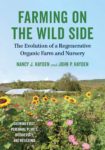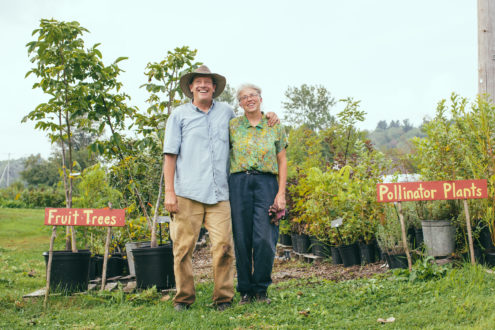Sep 17, 2019‘Wild Side’ authors describe ‘planned chaos’ of fruit farm
Vermont fruit growers Nancy and John Hayden are the authors of “Farming on the Wild Side,” a book due out from Chelsea Green publishers Sept. 19.
The book discusses how they reverted their property into a biodiverse, semi-wild state, phasing out sheep and potatoes as they embraced apples, pears, stone fruits, uncommon berry crops. They also adopted different marketing and sales strategies.


The Farm Between, as they call it, is 18 acres in the hills of northern Vermont. They’ve worked it for about 25 years. Here are some excerpts from an interview distributed by the publisher:
John Hayden: “This was not a prosperous farm when we bought it. They’d gone out of business. It looked nice. Everything was mowed and edged and painted, like a picture you see on a milk carton. Now, this is what a prosperous farm looks like. It’s scruffy. It’s chaotic, but it’s a planned chaos. We’ve got to rethink ‘pretty’. We have the functional beauty of all the biodiversity going on. We’re supporting the pollinators and the birds with all this habitat. There are beneficial insects living here eating up the pests, so we don’t need any pesticides or fertilizers. I came out this morning, and saw a bunch of monarch butterflies. We purposely cultivate milkweed, so we’re getting a decent population here.
“We used to grow vegetables, but [The Farm Between] is in a flood zone. When we lost a crop, we decided we needed to switch things up. Now we have aronia, black choker. This is an awesome plant. It has the highest antioxidants that you can grow. It’s very cold hardy, and it’s beautiful. The leaves all turn red in the fall.
“We’re constantly experimenting…. We planted apple trees on 20-foot spacing and then put cover crops in the alleys that also serve as pollinator habitat. It’s got a mix of different species…some perennial vegetables, like sea kale. It produces a loose floret that’s really delicious. We’ll just let it go to seed this year to see what happens.”
Letting plants do what they naturally do to learn about them is intuitive and makes a ton of sense.
Hayden: “Yes, we spend a lot of time just observing. An apple orchard is what we want, so we’re trying to find out what works in between. All this biodiversity helps us keep our pest population stable. We don’t have big outbreaks. We can take a 10% loss and it’s no big deal because we don’t have any inputs. We’re not applying pesticides and avoid all the effort that goes with that.”
Is it more profitable as far as your gain? Your harvest?
Hayden: “The harvest might be lighter than a commercial apple crop, but because our inputs are less, the profit’s better. We don’t have the expenses that commercial, monoculture growers have. The monoculture mentality is not ecological thinking, and we’re paying the price. The costs are put off onto society with the pesticides and the run-off and the soil erosion—all these negative things. We’re reimagining a transformational way of farming that doesn’t put costs on society. We’re bringing benefits to society: We’re sequestering carbon; we support pollinators and other wildlife; we’re slowing down the water with all these plants and root structures and pulling all the nutrients out of the water before it flows off our land. Even our ditches are full of trees that suck out the phosphorous before it goes downstream. The whole watershed drains through our farm, so the trees down in the riparian zone act as filters in addition to storing carbon. We use them for woodchips for mulch. We cut them and coppice them, and they grow back. Everything’s working together. We’re trying to stack as many functions as we can into this space.
“Monoculture farms have one function: grow the crop. And it’s all at risk. Pesticides are a risk reduction strategy, and the pesticide companies know it. They show you big scary pictures of pests. Not all farmers are biologists, though; they don’t follow the pest lifecycle that closely, so they see a pest, panic, and spray, even if they’d rather not. Their crops are a commodity, too, so they’re not getting the highest value. They’re selling it wholesale; their margins are small. They can’t afford to lose 10 percent of their crop. Here, we have about 30 different crops, so if I lose even 20 percent of my apples, some other crop is going to make up for that. Every year, some crops are stellar, some are mediocre, and some are bad, but it all balances out to be good.
“We’re not just tweaking a broken system; we’re developing a better one. We don’t have all the answers. We’re still playing around and observing and figuring things out, but we’ve got some good leads. We’re interacting. We’re immersed in this, and we’re watching, revamping, and learning. And we’re doing okay! Economically, we’re a lot stronger than when we were livestock or vegetable farmers. We’re growing higher-value products and have found great markets for them. It may appear helter-skelter, but a lot of thought goes into how we farm. We try to figure out the least amount of work we can possibly do and still make a decent living, and be doing good for our environment. We’re not trying to maximize profit or maximize yields. We’re trying to find that optimal balance.”
Above, John and Nancy Hayden are the authors of “Farming on the Wild Side.” Photo: Chelsea Green Publishing/JessicaSipe















